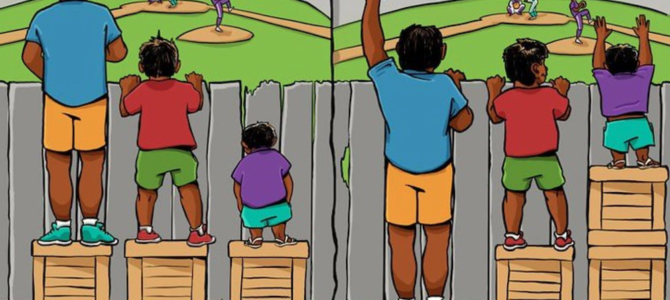
Imagine that a state board of education passed a resolution adopting “liberty” as its educational framework, pledged to “review and appropriately revise its policies using a liberty lens,” and created a “liberty officer” who received unspecified power to ensure every group achieved “liberty” in their educational outcomes.
Parents would understandably be alarmed. They would ask questions like: How is “liberty” being defined? Will there be any public oversight of the “liberty officer”? What will be the checks on his or her power? If the entire public school system adopts “liberty” as a framework, what role will education play? Are there any constraints on what can be done in the name of “liberty”?
If this scenario sounds far-fetched, substitute the word “equity” for the word “liberty,” and you’ll arrive at an actual resolution the North Carolina State Board of Education is considering.
What Is Equity?
Equity is a buzzword in education today, with numerous major school systems committing to incorporate it into the curriculum. If you consult the dictionary, “equity” means “the quality of being fair and impartial,” something no parent or educator would dream of opposing. Given this definition, it’s natural to assume equity is merely a synonym of “equality.”
When used in the context of contemporary education, activism, and public policy, however, equity generally means something very different. For example, the Glossary for Education Reform states:
While it is often used interchangeably with the related principle of equality, equity encompasses a wide variety of educational models, programs, and strategies that may be considered fair, but not necessarily equal. It is has been said that “equity is the process; equality is the outcome,” given that equity — what is fair and just — may not, in the process of educating students, reflect strict equality — what is applied, allocated, or distributed equally.
A popular image commissioned by the Interaction Institute for Social Change illustrates the difference between equality and equity in practice.

Note that equality entails giving all three people equal resources but leads to an undesirable outcome, while equity produces a desirable outcome by supposing that some people require unequal resources to offset their disadvantages.
How Does the Resolution Understand ‘Equity’?
At first glance, the North Carolina resolution appears to be defining equity in terms of equality of opportunity. It maintains that the state Constitution legally obligates the board of education to “ensure equity, demanding ‘equal opportunities shall be provided for all students.’”
Elsewhere, it explicitly defines “educational equity” as “the belief and practice of ensuring that every student is treated in a fair and just manner” and even says that “equity is equality of opportunity.”
Despite these statements, the resolution mentions in passing that “punitive disciplinary practices, lack of access to and supports for teachers of color, unequal access to educational opportunities and supports, implicit and explicit biases, and segregation perpetuate inequity in the outcomes of students.” This statement should give the reader pause. If equity means “equality of opportunity,” then presumably inequity means “inequality of opportunity.” But how can outcomes be inequitable if equity refers to opportunity, not to outcome?
Indeed, since the document insists that the North Carolina Constitution already commits the state to provide equality of opportunity, this entire resolution is irrelevant and unnecessary, unless equity means something besides equality of opportunity.
What Would It Take?
Even if we table the question of how exactly the word “equity” is being used, we can ask: What would an equity framework practically require? According to the document, treating students in a “fair and just” manner involves “eliminating discriminatory barriers to full participation and opportunities for every student.” These barriers include “systematic racism, poverty, poor health, unsafe environments, nutrition deficiencies, [and] limited access to services and infrastructure needed to support their long-term health and safety.”
A moment’s reflection shows the breathtaking magnitude of this assertion. If “equity” demands we remove barriers such as “poverty” and “unsafe environments,” imagine the kind of power that will have to be granted to the school system, and the equity officer specifically, to achieve these goals.
How precisely could any school system eliminate the barriers of poverty or poor health? Since it obviously can’t, will the pursuit of equity simply be used as an excuse to divert more and more power and resources to an office committed to an unattainable goal?
Here, questions of oversight and accountability become extremely important. The resolution calls the state to reorient the school system around an “equity framework.” Yet the so-called equity officer is the only person charged with “ensur[ing] consistency and continuity with this essential guiding principle inside and outside the agency.”
This approach effectively invests a single person with the tremendous power of determining which policies are consistent with what is now the “essential guiding principle” of the school system. Even if we think equity — whatever it is — is a noble goal, we dare not entrust any one person with this kind of tremendous power, absent any checks or balances.
The Resolution Is a Recipe for Injustice
The language and overall thrust of this resolution are concerning. If the board members believe that, contrary to the state Constitution, students should be treated unequally to ensure equality of outcome, they should say so explicitly.
Without question, some unequal treatment is compatible with justice and fairness, such as when schools provide extra resources and tutoring to students with learning disabilities or free lunches to students experiencing poverty. Yet other unequal treatment is unjust and unfair, such as when North Carolina spent decades discriminating against non-Caucasian students.
If the board of education is proposing we shift our entire education system to a framework that prioritizes equal outcome over equal treatment, it will have to draw very clear lines to ensure that in the pursuit of justice, it doesn’t inscribe injustice on the heart of our educational system. This resolution draws no such lines, and therefore, we should view it with extreme skepticism.









